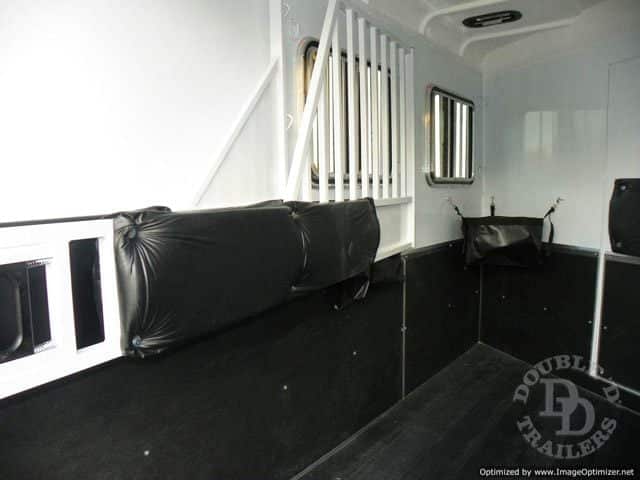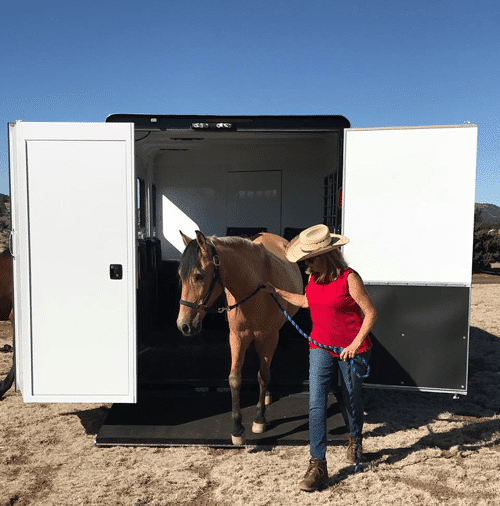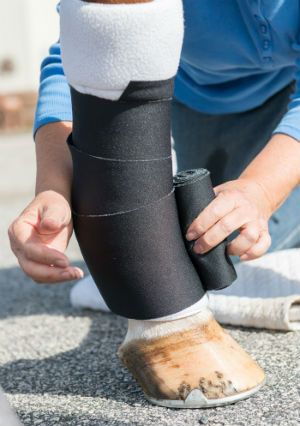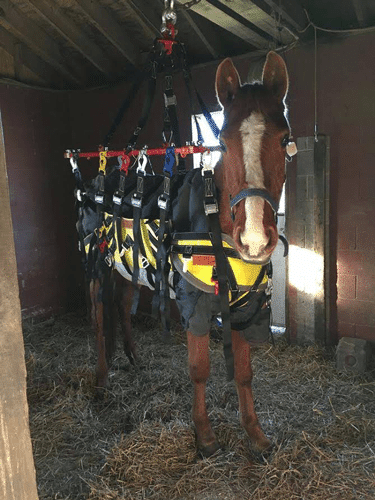Horse Trailer Use for Sick or Injured Horses
 Most of the time, we think about horse trailer safety in regards to healthy animals. But what needs to happen to horse transport when a horse is sick or injured? What special safety precautions or considerations need to be observed?
Most of the time, we think about horse trailer safety in regards to healthy animals. But what needs to happen to horse transport when a horse is sick or injured? What special safety precautions or considerations need to be observed?
We spoke with Dr. Brian Burks, a Board Certified Equine Specialist, of Fox Run Equine Center in Apollo, Pennsylvania. He shared some valuable information that will help owners who need to transport their animals even when they are ill, injured, pregnant, or severely malnourished.
Do This Before Trailering a Sick or Injured Horse
 As with any horse about to be loaded onto a horse trailer, Dr. Burks recommends that you give the interior a careful inspection before loading your horse.
As with any horse about to be loaded onto a horse trailer, Dr. Burks recommends that you give the interior a careful inspection before loading your horse.
“The trailer should be clean and empty of debris, hay bags, leads, etc,” he explained. “There should be nothing for the horse to step on or get wrapped around a limb. The floor should be safe, the lights in working order, and the brakes working.”
He also added that the trailer should be hitched properly before loading your horse.
Next, you should take your horse’s vital signs and make sure that the animal is stable for transport. According to theHORSE.com, your adult horse should have a temperature of 99-101 degrees Fahrenheit, a pulse of 28-44 beats per minute, and respiration of 10-24 breaths per minute.
His mucous membranes should be moist with a healthy pink color and the capillary refill time (when pressing on their mouth gums with a finger) should be two seconds or less. Finally, there should be gurgling gassy growls coming from their stomach to indicate proper digestion.
Dr. Burks explained that some horses may need to be transported even though they are unstable. This would be the case for animals with fractures, colic, or cardiopulmonary disorders. For these horses, “It’s like having a heart attack and being transported in an ambulance.”
Consult Your Veterinarian Before Transport
Before you load your sick or injured horses, it’s a good idea to also consult with your veterinarian to get advice for their specific case.
“The veterinarian can determine if the horse is safe to transport or needs to be stabilized on the farm first,” Dr. Burks shared.
A common and very scary condition for horse owners is colic. Many of these animals need surgery to repair damage done by rolling with compacted bowels. Dr. Burks told us that horses that are in the midst of colic and thrashing around are not good candidates for transport. If they try to lie down and roll while in the trailer, they could further injure themselves or damage the trailer.
On the other hand, “Horses with colic that simply want to lie down, even flat out, can be transported in recumbency, making sure to remove the center divider or leave dividers in a slant load latched open to leave space open just in case the horse wants to rise.”
In every situation, horse owners need to consider the safety of their animals. Anytime a horse is laying or rolling within a trailer, they risk sticking a limb or head out a window during travel, which can be very dangerous.
What Types of Horse Trailers Work Best for Transporting Sick or Injured Horses?

Dr. Burks explained, “Most veterinary clinics do not [own these special trailers,] though there are a few.”
Sometimes, vets need to get creative to help a compromised horse. “If a horse’s limbs are not stable from neurologic disease or facture, hay bales can be used to wedge the horse onto one side so they will not fall. I have found that there are ways to make most trailers work if the horse is not thrashing in pain.”
For Dr. Burks, gooseneck horse trailers provide the smoothest ride with bumper pull horse trailers that have weight distribution hitches as a close second. He also pointed out the benefits of trailers that let the horse walk forwards to offload. “Slant load or stock trailers enable the horse to turn around in the trailer so that backing onto an injured back limb is not required.”
We’d like to add that our SafeTack Reverse trailers would also work well for this type of use. A horse can load from the side ramp into a rear facing stall and then walk forwards off the rear of the trailer to offload. They would never need to back up on an injured limb.
Finally, Dr. Burks considers the stock trailer to provide the bumpiest type of ride for an injured or ill animal.
What to Do to Protect Your Horse after Transport is Approved

First, if your horse has a limb injury, the leg should be wrapped using a lot of padding. Dr. Burks cautioned, “Tape or vet wrap should never be used without adequate padding. Limbs are easily injured by inadequate padding and tight vet wrap.”
He continued, “In a pinch, lacerations, especially when hemorrhaging, can be wrapped with bath towels and taped with duct tape. Fractures can be stabilized with splints and heavy wraps. Of course limb boots, or other wraps, and head bumpers can also be used.”
In the case of an eye injury, Dr. Burks had some creative advice. “A fly mask, or even a bra can be used to cover an injured eye, cutting out the material over the good eye for vision.”
Regardless of how much you’d like to watch over your horse, it is never a good idea to ride in the trailer with the horse. In fact, it is illegal. “It is dangerous as the horse can severely injure someone or the trailer can flip over/come unhitched and there is no protection for any human inside a metal box.”
How Do Experts Transport the Most Severe Cases?
One of the organizations that Dr. Burks works with frequently is the Rory Ridge Rescue in Templeton, PA. Horse rescues are unique in that they often need to transport severely malnourished horses that are too weak to stand. Dr. Burks shared some information about helping these most severe cases.
“Those horses are transported while recumbent. Recumbent horses can be pulled onto a trailer with a glide, tarp, plywood, etc. CART teams are invaluable in this regard for manpower alone, but also their training in moving injured horses.”

Properly placed straps can be used to pull an injured or otherwise recumbent horse out of a dangerous zone, or, very occasionally, onto a trailer. Once at the hospital, the veterinary staff uses a sling to assist the horse with standing.
“It is most appropriate to have these horses in the hospital where intensive treatment can be done by those with proper training. Rescues do not have the man power, and often little to no training, to deal with severely malnourished horses.”
Any horse that is severely malnourished is vulnerable to a condition called “refeeding syndrome” so they need to be brought back to a safe weight with careful medical supervision.
Remember that your sick or injured horse needs some special attention when it comes to transport. We always recommend caution so that you can make the best decisions for your horse’s safety and health.
If you’d like to learn more about horse rescues and the challenges they face, be sure to check out the resources on our Horse Rescue Corner.
If you have any questions about transporting your sick or injured horse, we recommend that you speak directly with your own veterinarian. They will be able to give you additional information.
Finally, if you’d like to learn more about Dr. Brian Burks, please visit the Fox Run Equine Center website at www.foxrunequine.com. A special thanks to Dr. Burks for sharing his expertise!

